Business Environment: Analysis of Organizations and Factors Report
VerifiedAdded on 2020/06/05
|9
|3037
|114
Report
AI Summary
This report examines the business environment, focusing on two organizations: Marks and Spencer (M&S) and the National Health Service (NHS). It explores different types of businesses, their purposes, and ownership structures, highlighting the role of stakeholders and how they influence organizational goals. The report delves into organizational structures, including functional areas, and how these structures help fulfill business purposes. It further analyzes the impact of economic factors like employment, inflation, and interest rates on business activities. Finally, the report discusses the influence of political, legal, and social factors, such as taxation, infrastructure, and government schemes, on businesses and their stakeholders. The analysis provides insights into how businesses adapt to changing environments and maintain efficiency.

BUSINESS ENVIRONMENT
Paraphrase This Document
Need a fresh take? Get an instant paraphrase of this document with our AI Paraphraser
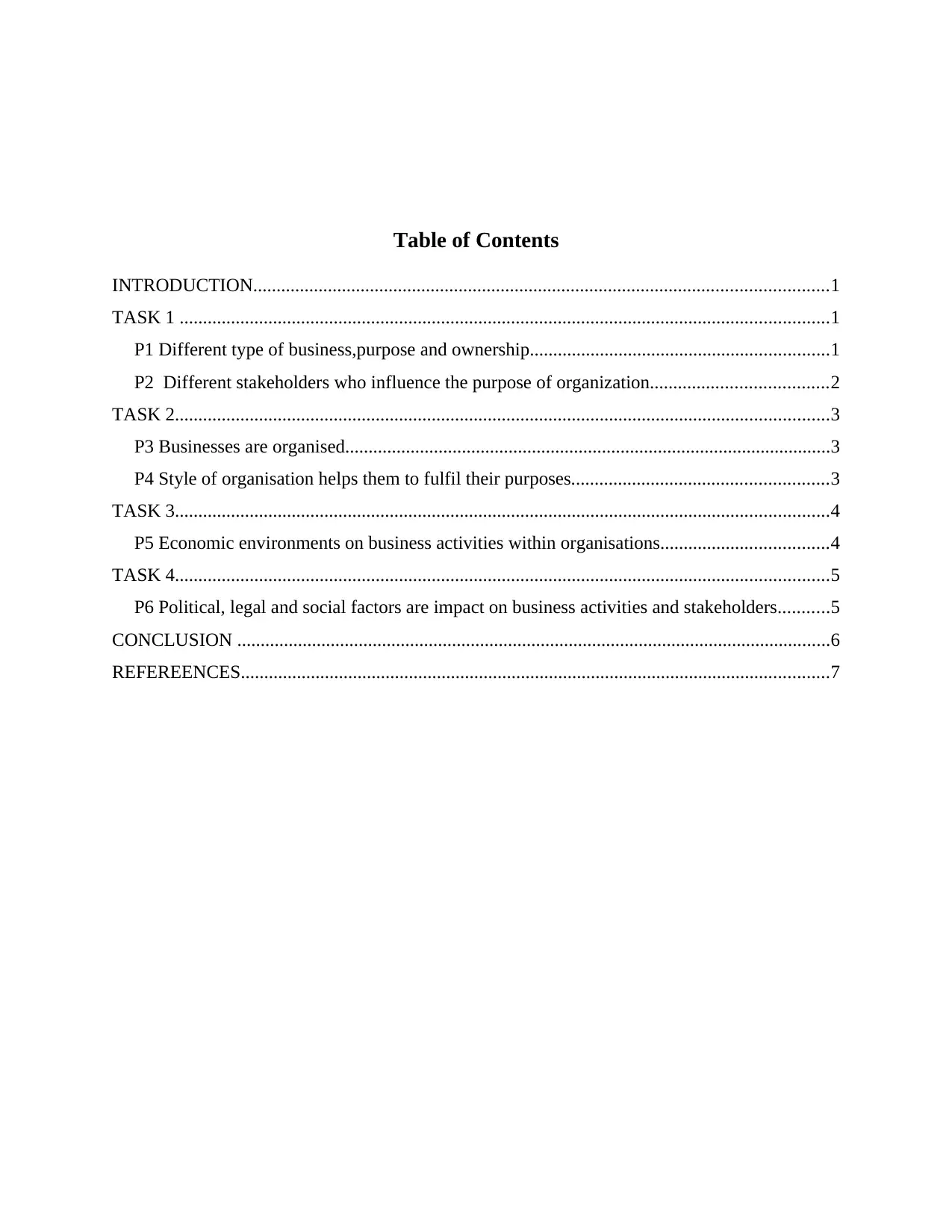
Table of Contents
INTRODUCTION...........................................................................................................................1
TASK 1 ...........................................................................................................................................1
P1 Different type of business,purpose and ownership................................................................1
P2 Different stakeholders who influence the purpose of organization......................................2
TASK 2............................................................................................................................................3
P3 Businesses are organised........................................................................................................3
P4 Style of organisation helps them to fulfil their purposes.......................................................3
TASK 3............................................................................................................................................4
P5 Economic environments on business activities within organisations....................................4
TASK 4............................................................................................................................................5
P6 Political, legal and social factors are impact on business activities and stakeholders...........5
CONCLUSION ...............................................................................................................................6
REFEREENCES..............................................................................................................................7
INTRODUCTION...........................................................................................................................1
TASK 1 ...........................................................................................................................................1
P1 Different type of business,purpose and ownership................................................................1
P2 Different stakeholders who influence the purpose of organization......................................2
TASK 2............................................................................................................................................3
P3 Businesses are organised........................................................................................................3
P4 Style of organisation helps them to fulfil their purposes.......................................................3
TASK 3............................................................................................................................................4
P5 Economic environments on business activities within organisations....................................4
TASK 4............................................................................................................................................5
P6 Political, legal and social factors are impact on business activities and stakeholders...........5
CONCLUSION ...............................................................................................................................6
REFEREENCES..............................................................................................................................7
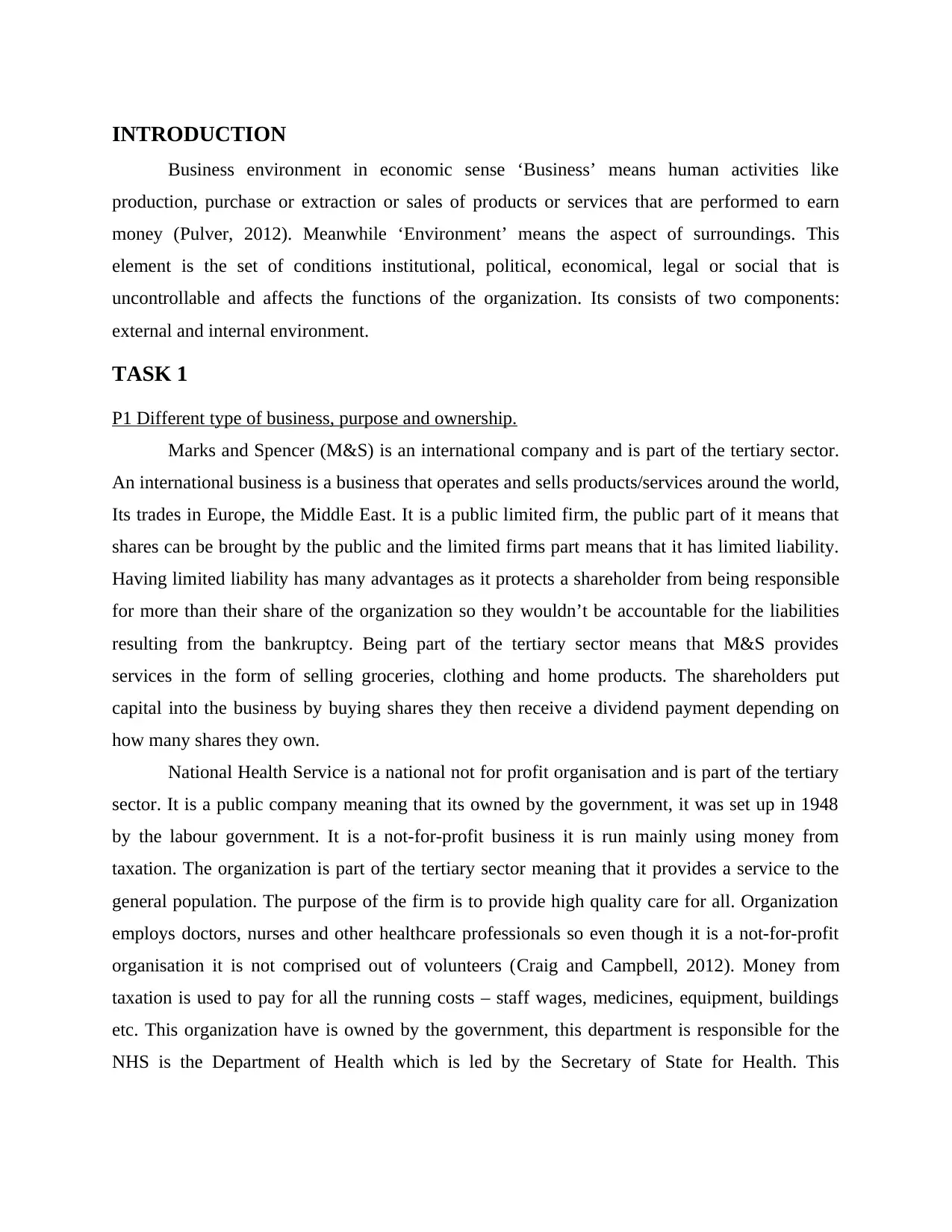
INTRODUCTION
Business environment in economic sense ‘Business’ means human activities like
production, purchase or extraction or sales of products or services that are performed to earn
money (Pulver, 2012). Meanwhile ‘Environment’ means the aspect of surroundings. This
element is the set of conditions institutional, political, economical, legal or social that is
uncontrollable and affects the functions of the organization. Its consists of two components:
external and internal environment.
TASK 1
P1 Different type of business, purpose and ownership.
Marks and Spencer (M&S) is an international company and is part of the tertiary sector.
An international business is a business that operates and sells products/services around the world,
Its trades in Europe, the Middle East. It is a public limited firm, the public part of it means that
shares can be brought by the public and the limited firms part means that it has limited liability.
Having limited liability has many advantages as it protects a shareholder from being responsible
for more than their share of the organization so they wouldn’t be accountable for the liabilities
resulting from the bankruptcy. Being part of the tertiary sector means that M&S provides
services in the form of selling groceries, clothing and home products. The shareholders put
capital into the business by buying shares they then receive a dividend payment depending on
how many shares they own.
National Health Service is a national not for profit organisation and is part of the tertiary
sector. It is a public company meaning that its owned by the government, it was set up in 1948
by the labour government. It is a not-for-profit business it is run mainly using money from
taxation. The organization is part of the tertiary sector meaning that it provides a service to the
general population. The purpose of the firm is to provide high quality care for all. Organization
employs doctors, nurses and other healthcare professionals so even though it is a not-for-profit
organisation it is not comprised out of volunteers (Craig and Campbell, 2012). Money from
taxation is used to pay for all the running costs – staff wages, medicines, equipment, buildings
etc. This organization have is owned by the government, this department is responsible for the
NHS is the Department of Health which is led by the Secretary of State for Health. This
Business environment in economic sense ‘Business’ means human activities like
production, purchase or extraction or sales of products or services that are performed to earn
money (Pulver, 2012). Meanwhile ‘Environment’ means the aspect of surroundings. This
element is the set of conditions institutional, political, economical, legal or social that is
uncontrollable and affects the functions of the organization. Its consists of two components:
external and internal environment.
TASK 1
P1 Different type of business, purpose and ownership.
Marks and Spencer (M&S) is an international company and is part of the tertiary sector.
An international business is a business that operates and sells products/services around the world,
Its trades in Europe, the Middle East. It is a public limited firm, the public part of it means that
shares can be brought by the public and the limited firms part means that it has limited liability.
Having limited liability has many advantages as it protects a shareholder from being responsible
for more than their share of the organization so they wouldn’t be accountable for the liabilities
resulting from the bankruptcy. Being part of the tertiary sector means that M&S provides
services in the form of selling groceries, clothing and home products. The shareholders put
capital into the business by buying shares they then receive a dividend payment depending on
how many shares they own.
National Health Service is a national not for profit organisation and is part of the tertiary
sector. It is a public company meaning that its owned by the government, it was set up in 1948
by the labour government. It is a not-for-profit business it is run mainly using money from
taxation. The organization is part of the tertiary sector meaning that it provides a service to the
general population. The purpose of the firm is to provide high quality care for all. Organization
employs doctors, nurses and other healthcare professionals so even though it is a not-for-profit
organisation it is not comprised out of volunteers (Craig and Campbell, 2012). Money from
taxation is used to pay for all the running costs – staff wages, medicines, equipment, buildings
etc. This organization have is owned by the government, this department is responsible for the
NHS is the Department of Health which is led by the Secretary of State for Health. This
⊘ This is a preview!⊘
Do you want full access?
Subscribe today to unlock all pages.

Trusted by 1+ million students worldwide
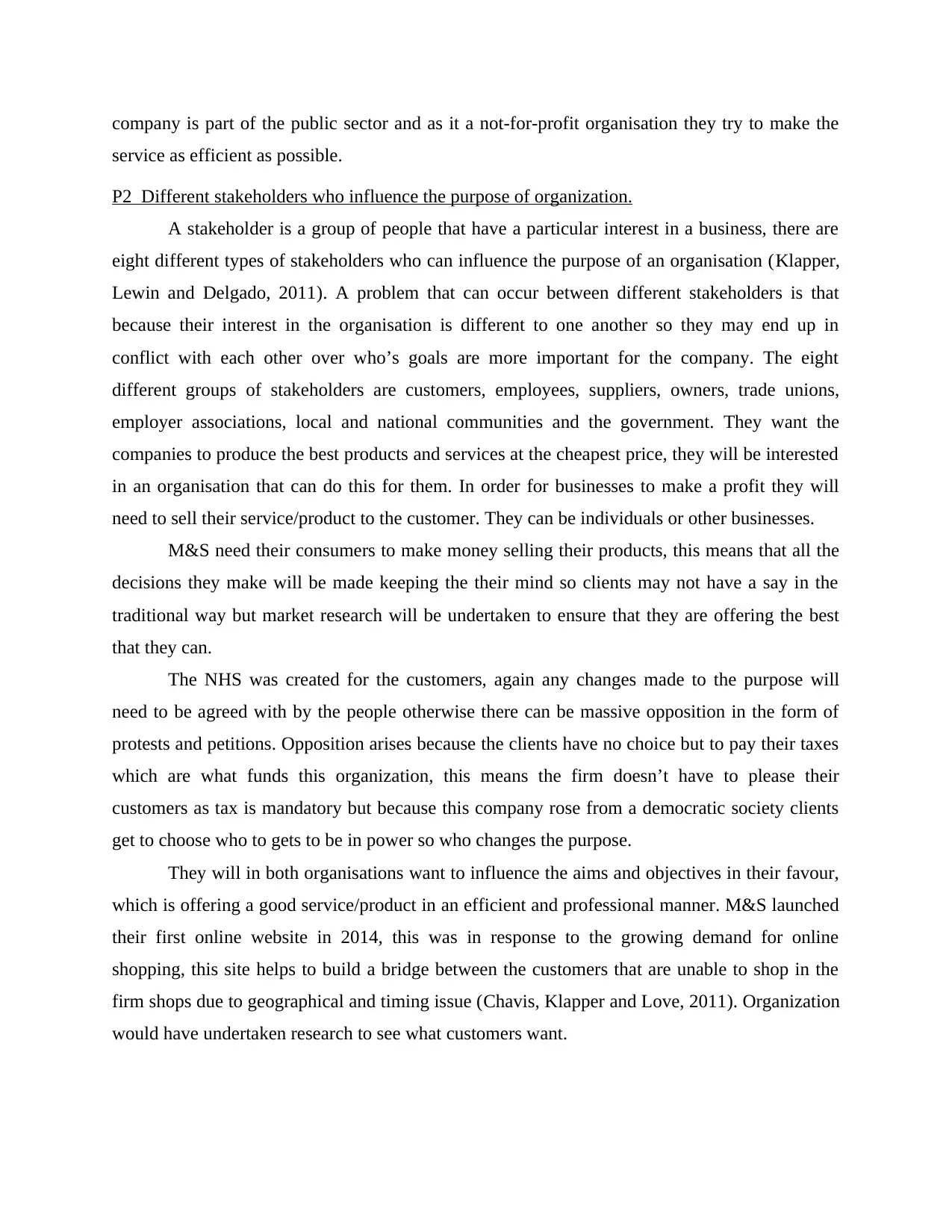
company is part of the public sector and as it a not-for-profit organisation they try to make the
service as efficient as possible.
P2 Different stakeholders who influence the purpose of organization.
A stakeholder is a group of people that have a particular interest in a business, there are
eight different types of stakeholders who can influence the purpose of an organisation (Klapper,
Lewin and Delgado, 2011). A problem that can occur between different stakeholders is that
because their interest in the organisation is different to one another so they may end up in
conflict with each other over who’s goals are more important for the company. The eight
different groups of stakeholders are customers, employees, suppliers, owners, trade unions,
employer associations, local and national communities and the government. They want the
companies to produce the best products and services at the cheapest price, they will be interested
in an organisation that can do this for them. In order for businesses to make a profit they will
need to sell their service/product to the customer. They can be individuals or other businesses.
M&S need their consumers to make money selling their products, this means that all the
decisions they make will be made keeping the their mind so clients may not have a say in the
traditional way but market research will be undertaken to ensure that they are offering the best
that they can.
The NHS was created for the customers, again any changes made to the purpose will
need to be agreed with by the people otherwise there can be massive opposition in the form of
protests and petitions. Opposition arises because the clients have no choice but to pay their taxes
which are what funds this organization, this means the firm doesn’t have to please their
customers as tax is mandatory but because this company rose from a democratic society clients
get to choose who to gets to be in power so who changes the purpose.
They will in both organisations want to influence the aims and objectives in their favour,
which is offering a good service/product in an efficient and professional manner. M&S launched
their first online website in 2014, this was in response to the growing demand for online
shopping, this site helps to build a bridge between the customers that are unable to shop in the
firm shops due to geographical and timing issue (Chavis, Klapper and Love, 2011). Organization
would have undertaken research to see what customers want.
service as efficient as possible.
P2 Different stakeholders who influence the purpose of organization.
A stakeholder is a group of people that have a particular interest in a business, there are
eight different types of stakeholders who can influence the purpose of an organisation (Klapper,
Lewin and Delgado, 2011). A problem that can occur between different stakeholders is that
because their interest in the organisation is different to one another so they may end up in
conflict with each other over who’s goals are more important for the company. The eight
different groups of stakeholders are customers, employees, suppliers, owners, trade unions,
employer associations, local and national communities and the government. They want the
companies to produce the best products and services at the cheapest price, they will be interested
in an organisation that can do this for them. In order for businesses to make a profit they will
need to sell their service/product to the customer. They can be individuals or other businesses.
M&S need their consumers to make money selling their products, this means that all the
decisions they make will be made keeping the their mind so clients may not have a say in the
traditional way but market research will be undertaken to ensure that they are offering the best
that they can.
The NHS was created for the customers, again any changes made to the purpose will
need to be agreed with by the people otherwise there can be massive opposition in the form of
protests and petitions. Opposition arises because the clients have no choice but to pay their taxes
which are what funds this organization, this means the firm doesn’t have to please their
customers as tax is mandatory but because this company rose from a democratic society clients
get to choose who to gets to be in power so who changes the purpose.
They will in both organisations want to influence the aims and objectives in their favour,
which is offering a good service/product in an efficient and professional manner. M&S launched
their first online website in 2014, this was in response to the growing demand for online
shopping, this site helps to build a bridge between the customers that are unable to shop in the
firm shops due to geographical and timing issue (Chavis, Klapper and Love, 2011). Organization
would have undertaken research to see what customers want.
Paraphrase This Document
Need a fresh take? Get an instant paraphrase of this document with our AI Paraphraser
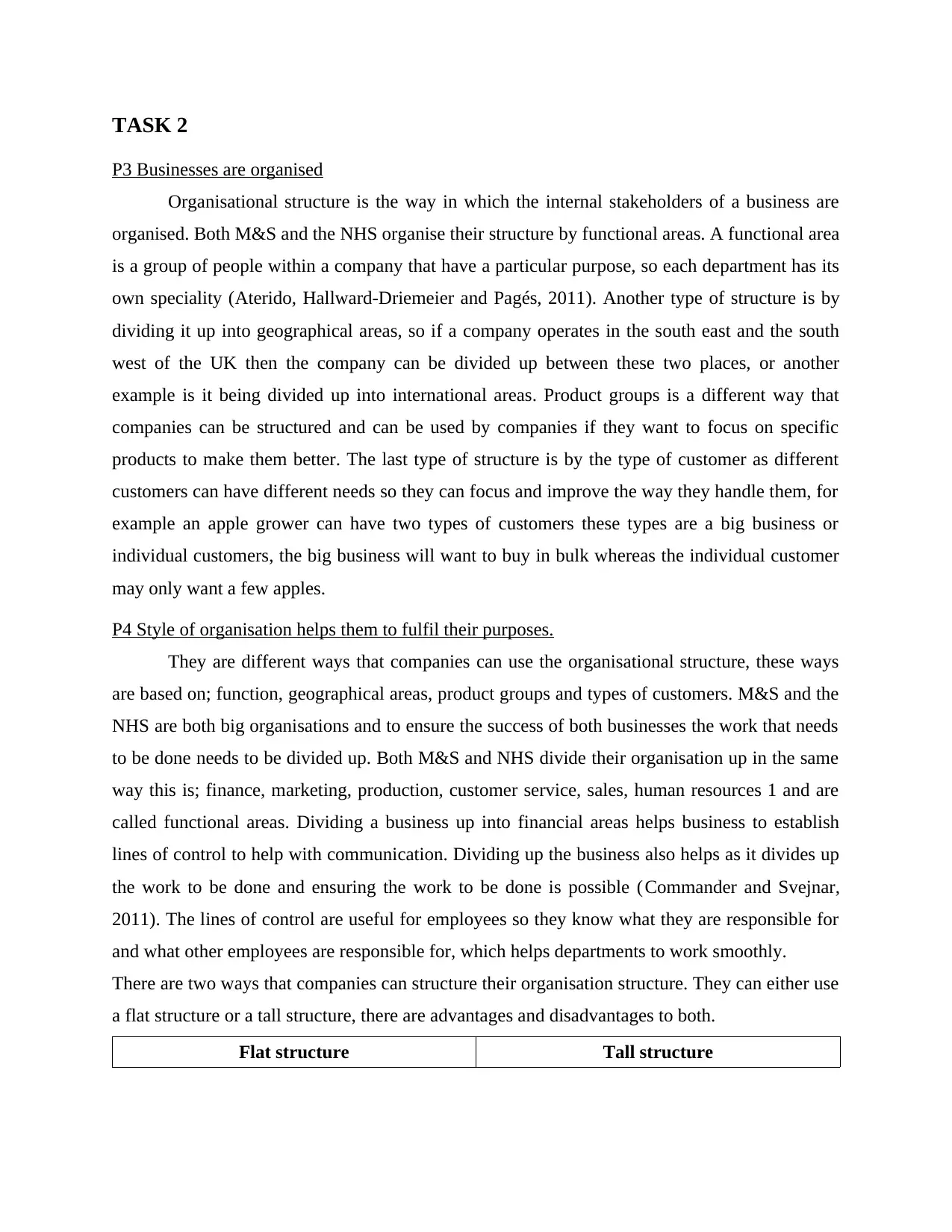
TASK 2
P3 Businesses are organised
Organisational structure is the way in which the internal stakeholders of a business are
organised. Both M&S and the NHS organise their structure by functional areas. A functional area
is a group of people within a company that have a particular purpose, so each department has its
own speciality (Aterido, Hallward-Driemeier and Pagés, 2011). Another type of structure is by
dividing it up into geographical areas, so if a company operates in the south east and the south
west of the UK then the company can be divided up between these two places, or another
example is it being divided up into international areas. Product groups is a different way that
companies can be structured and can be used by companies if they want to focus on specific
products to make them better. The last type of structure is by the type of customer as different
customers can have different needs so they can focus and improve the way they handle them, for
example an apple grower can have two types of customers these types are a big business or
individual customers, the big business will want to buy in bulk whereas the individual customer
may only want a few apples.
P4 Style of organisation helps them to fulfil their purposes.
They are different ways that companies can use the organisational structure, these ways
are based on; function, geographical areas, product groups and types of customers. M&S and the
NHS are both big organisations and to ensure the success of both businesses the work that needs
to be done needs to be divided up. Both M&S and NHS divide their organisation up in the same
way this is; finance, marketing, production, customer service, sales, human resources 1 and are
called functional areas. Dividing a business up into financial areas helps business to establish
lines of control to help with communication. Dividing up the business also helps as it divides up
the work to be done and ensuring the work to be done is possible (Commander and Svejnar,
2011). The lines of control are useful for employees so they know what they are responsible for
and what other employees are responsible for, which helps departments to work smoothly.
There are two ways that companies can structure their organisation structure. They can either use
a flat structure or a tall structure, there are advantages and disadvantages to both.
Flat structure Tall structure
P3 Businesses are organised
Organisational structure is the way in which the internal stakeholders of a business are
organised. Both M&S and the NHS organise their structure by functional areas. A functional area
is a group of people within a company that have a particular purpose, so each department has its
own speciality (Aterido, Hallward-Driemeier and Pagés, 2011). Another type of structure is by
dividing it up into geographical areas, so if a company operates in the south east and the south
west of the UK then the company can be divided up between these two places, or another
example is it being divided up into international areas. Product groups is a different way that
companies can be structured and can be used by companies if they want to focus on specific
products to make them better. The last type of structure is by the type of customer as different
customers can have different needs so they can focus and improve the way they handle them, for
example an apple grower can have two types of customers these types are a big business or
individual customers, the big business will want to buy in bulk whereas the individual customer
may only want a few apples.
P4 Style of organisation helps them to fulfil their purposes.
They are different ways that companies can use the organisational structure, these ways
are based on; function, geographical areas, product groups and types of customers. M&S and the
NHS are both big organisations and to ensure the success of both businesses the work that needs
to be done needs to be divided up. Both M&S and NHS divide their organisation up in the same
way this is; finance, marketing, production, customer service, sales, human resources 1 and are
called functional areas. Dividing a business up into financial areas helps business to establish
lines of control to help with communication. Dividing up the business also helps as it divides up
the work to be done and ensuring the work to be done is possible (Commander and Svejnar,
2011). The lines of control are useful for employees so they know what they are responsible for
and what other employees are responsible for, which helps departments to work smoothly.
There are two ways that companies can structure their organisation structure. They can either use
a flat structure or a tall structure, there are advantages and disadvantages to both.
Flat structure Tall structure
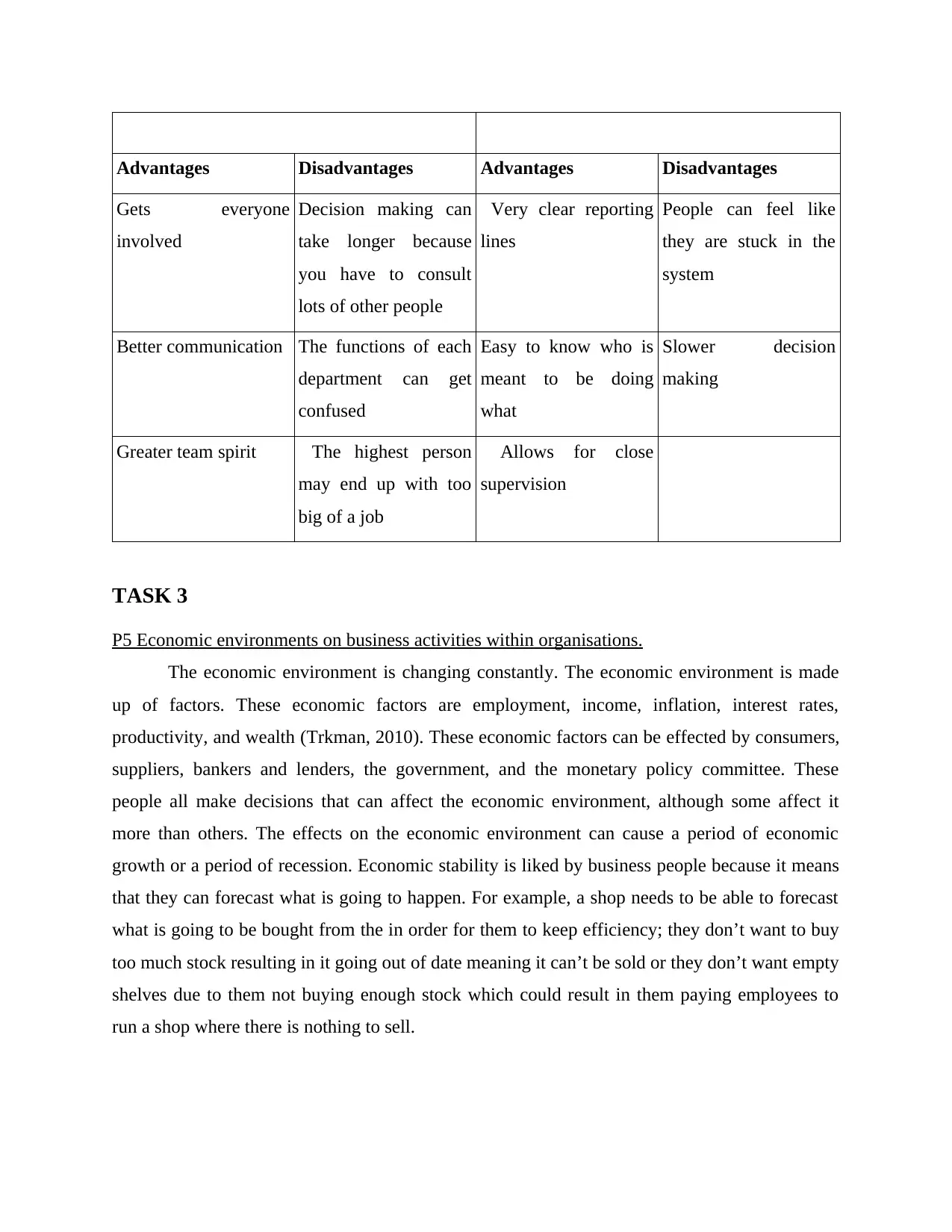
Advantages Disadvantages Advantages Disadvantages
Gets everyone
involved
Decision making can
take longer because
you have to consult
lots of other people
Very clear reporting
lines
People can feel like
they are stuck in the
system
Better communication The functions of each
department can get
confused
Easy to know who is
meant to be doing
what
Slower decision
making
Greater team spirit The highest person
may end up with too
big of a job
Allows for close
supervision
TASK 3
P5 Economic environments on business activities within organisations.
The economic environment is changing constantly. The economic environment is made
up of factors. These economic factors are employment, income, inflation, interest rates,
productivity, and wealth (Trkman, 2010). These economic factors can be effected by consumers,
suppliers, bankers and lenders, the government, and the monetary policy committee. These
people all make decisions that can affect the economic environment, although some affect it
more than others. The effects on the economic environment can cause a period of economic
growth or a period of recession. Economic stability is liked by business people because it means
that they can forecast what is going to happen. For example, a shop needs to be able to forecast
what is going to be bought from the in order for them to keep efficiency; they don’t want to buy
too much stock resulting in it going out of date meaning it can’t be sold or they don’t want empty
shelves due to them not buying enough stock which could result in them paying employees to
run a shop where there is nothing to sell.
Gets everyone
involved
Decision making can
take longer because
you have to consult
lots of other people
Very clear reporting
lines
People can feel like
they are stuck in the
system
Better communication The functions of each
department can get
confused
Easy to know who is
meant to be doing
what
Slower decision
making
Greater team spirit The highest person
may end up with too
big of a job
Allows for close
supervision
TASK 3
P5 Economic environments on business activities within organisations.
The economic environment is changing constantly. The economic environment is made
up of factors. These economic factors are employment, income, inflation, interest rates,
productivity, and wealth (Trkman, 2010). These economic factors can be effected by consumers,
suppliers, bankers and lenders, the government, and the monetary policy committee. These
people all make decisions that can affect the economic environment, although some affect it
more than others. The effects on the economic environment can cause a period of economic
growth or a period of recession. Economic stability is liked by business people because it means
that they can forecast what is going to happen. For example, a shop needs to be able to forecast
what is going to be bought from the in order for them to keep efficiency; they don’t want to buy
too much stock resulting in it going out of date meaning it can’t be sold or they don’t want empty
shelves due to them not buying enough stock which could result in them paying employees to
run a shop where there is nothing to sell.
⊘ This is a preview!⊘
Do you want full access?
Subscribe today to unlock all pages.

Trusted by 1+ million students worldwide
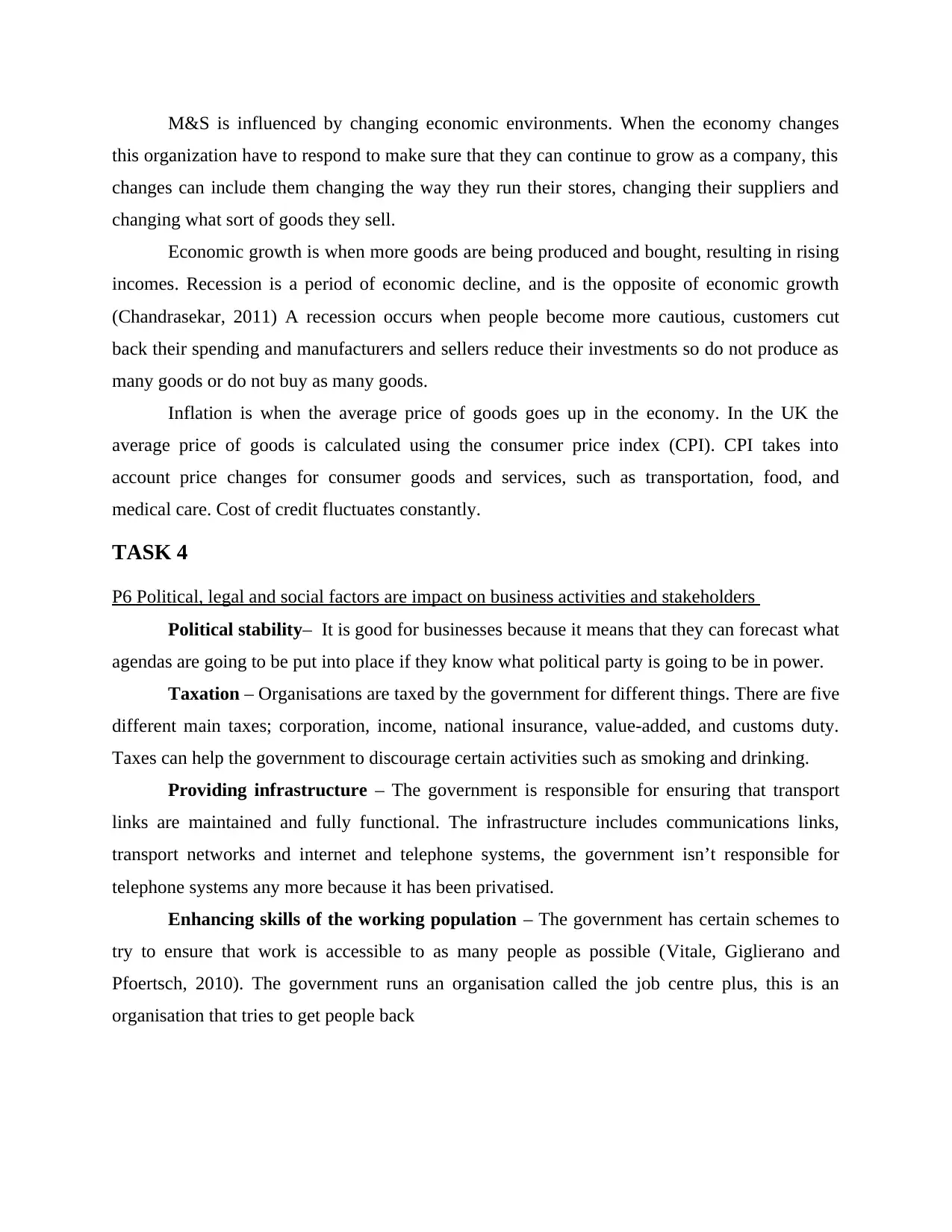
M&S is influenced by changing economic environments. When the economy changes
this organization have to respond to make sure that they can continue to grow as a company, this
changes can include them changing the way they run their stores, changing their suppliers and
changing what sort of goods they sell.
Economic growth is when more goods are being produced and bought, resulting in rising
incomes. Recession is a period of economic decline, and is the opposite of economic growth
(Chandrasekar, 2011) A recession occurs when people become more cautious, customers cut
back their spending and manufacturers and sellers reduce their investments so do not produce as
many goods or do not buy as many goods.
Inflation is when the average price of goods goes up in the economy. In the UK the
average price of goods is calculated using the consumer price index (CPI). CPI takes into
account price changes for consumer goods and services, such as transportation, food, and
medical care. Cost of credit fluctuates constantly.
TASK 4
P6 Political, legal and social factors are impact on business activities and stakeholders
Political stability– It is good for businesses because it means that they can forecast what
agendas are going to be put into place if they know what political party is going to be in power.
Taxation – Organisations are taxed by the government for different things. There are five
different main taxes; corporation, income, national insurance, value-added, and customs duty.
Taxes can help the government to discourage certain activities such as smoking and drinking.
Providing infrastructure – The government is responsible for ensuring that transport
links are maintained and fully functional. The infrastructure includes communications links,
transport networks and internet and telephone systems, the government isn’t responsible for
telephone systems any more because it has been privatised.
Enhancing skills of the working population – The government has certain schemes to
try to ensure that work is accessible to as many people as possible (Vitale, Giglierano and
Pfoertsch, 2010). The government runs an organisation called the job centre plus, this is an
organisation that tries to get people back
this organization have to respond to make sure that they can continue to grow as a company, this
changes can include them changing the way they run their stores, changing their suppliers and
changing what sort of goods they sell.
Economic growth is when more goods are being produced and bought, resulting in rising
incomes. Recession is a period of economic decline, and is the opposite of economic growth
(Chandrasekar, 2011) A recession occurs when people become more cautious, customers cut
back their spending and manufacturers and sellers reduce their investments so do not produce as
many goods or do not buy as many goods.
Inflation is when the average price of goods goes up in the economy. In the UK the
average price of goods is calculated using the consumer price index (CPI). CPI takes into
account price changes for consumer goods and services, such as transportation, food, and
medical care. Cost of credit fluctuates constantly.
TASK 4
P6 Political, legal and social factors are impact on business activities and stakeholders
Political stability– It is good for businesses because it means that they can forecast what
agendas are going to be put into place if they know what political party is going to be in power.
Taxation – Organisations are taxed by the government for different things. There are five
different main taxes; corporation, income, national insurance, value-added, and customs duty.
Taxes can help the government to discourage certain activities such as smoking and drinking.
Providing infrastructure – The government is responsible for ensuring that transport
links are maintained and fully functional. The infrastructure includes communications links,
transport networks and internet and telephone systems, the government isn’t responsible for
telephone systems any more because it has been privatised.
Enhancing skills of the working population – The government has certain schemes to
try to ensure that work is accessible to as many people as possible (Vitale, Giglierano and
Pfoertsch, 2010). The government runs an organisation called the job centre plus, this is an
organisation that tries to get people back
Paraphrase This Document
Need a fresh take? Get an instant paraphrase of this document with our AI Paraphraser

Legal impacts – The legal impacts are that M&S must follow the law, and an example of
this is the trade description act, this is where the product most be described accurately otherwise
it can cause an issue and an example of this the big issue with meat earlier this year, so it is
extremely important that you describe the product well and accurately if not then the trading
standards will have no other choice but to get involved (Tobin and Rose-Ackerman, 2011).
Consumer protection is when a group of laws and organisations have designed to ensure that the
rights of clients, these are put in place to hopefully prevent businesses that engage or are
planning on engaging in fraud or specified unfair practices to try and gain or taking an
advantage over competitors.
N&H is an standards authority, this is where they regulate the amount of salt that is
allowed in products and also the amount of palm oil that is allowed in the products and this is
from the sustainable rain forests. Health and safety standards are the most important, and for all
the new workers will have a full day having an induction before that are allowed to start their
job, they are also shown around their work place and they are also shown the areas that they
won’t be allowed to go due the dangerous machinery.
The legal frameworks is where the business chooses the way it operates, this will then
determine who has what role and share to the business, this will also determine the relationships
between investors, employee’s customers etc.
Social impacts- The social impacts that M&S may face are the difficulty to recruit the
right people for the job in the stores or the offices depending on where they will be based, also
most of the workers that are in the stores are an unskilled workers on the minimum wage given
(Trkman, 2010). This has a company cannot discriminate anyone from having a disability,
different religion or if they are pregnant and other things on this terms and when they are
employed by the company or if they are in the HR Department they are then recruiting they are
also not allowed to ask questions in these areas.
CONCLUSION
On the basis of this report it has been concluded that, different types of business
environment that affect on different ways on organization activity, function, goals and
objectives. Mark & Spencer and National health services both business entities have different
this is the trade description act, this is where the product most be described accurately otherwise
it can cause an issue and an example of this the big issue with meat earlier this year, so it is
extremely important that you describe the product well and accurately if not then the trading
standards will have no other choice but to get involved (Tobin and Rose-Ackerman, 2011).
Consumer protection is when a group of laws and organisations have designed to ensure that the
rights of clients, these are put in place to hopefully prevent businesses that engage or are
planning on engaging in fraud or specified unfair practices to try and gain or taking an
advantage over competitors.
N&H is an standards authority, this is where they regulate the amount of salt that is
allowed in products and also the amount of palm oil that is allowed in the products and this is
from the sustainable rain forests. Health and safety standards are the most important, and for all
the new workers will have a full day having an induction before that are allowed to start their
job, they are also shown around their work place and they are also shown the areas that they
won’t be allowed to go due the dangerous machinery.
The legal frameworks is where the business chooses the way it operates, this will then
determine who has what role and share to the business, this will also determine the relationships
between investors, employee’s customers etc.
Social impacts- The social impacts that M&S may face are the difficulty to recruit the
right people for the job in the stores or the offices depending on where they will be based, also
most of the workers that are in the stores are an unskilled workers on the minimum wage given
(Trkman, 2010). This has a company cannot discriminate anyone from having a disability,
different religion or if they are pregnant and other things on this terms and when they are
employed by the company or if they are in the HR Department they are then recruiting they are
also not allowed to ask questions in these areas.
CONCLUSION
On the basis of this report it has been concluded that, different types of business
environment that affect on different ways on organization activity, function, goals and
objectives. Mark & Spencer and National health services both business entities have different

type of environment, structure stakeholders, employees and many others elements. Identifying
the impact of legal, social and political function on the companies processes. And also determine
the economic environment are related to the different business activities.
REFERENCES
Books and journals
Aterido, R., Hallward-Driemeier, M. and Pagés, C., 2011. Big constraints to small firms’
growth? Business environment and employment growth across firms. Economic
Development and Cultural Change. 59(3). pp.609-647.
Chandrasekar, K., 2011. Workplace environment and its impact on organisational performance
in public sector organisations. International Journal of Enterprise Computing and
Business Systems. 1(1). pp.1-16.
Chavis, L.W., Klapper, L.F. and Love, I., 2011. The impact of the business environment on
young firm financing. The world bank economic review. 25(3). pp.486-507.
Commander, S. and Svejnar, J., 2011. Business environment, exports, ownership, and firm
performance. The Review of Economics and Statistics. 93(1). pp.309-337.
Craig, T. and Campbell, D., 2012. Organisations and the business environment. Routledge.
Klapper, L., Lewin, A. and Delgado, J.M.Q., 2011. The impact of the business environment on
the business creation process. In Entrepreneurship and Economic Development (pp.
108-123). Palgrave Macmillan UK.
Pulver, S., 2012. Business and the Environment.
Tobin, J.L. and Rose-Ackerman, S., 2011. When BITs have some bite: The political-economic
environment for bilateral investment treaties. The Review of International
Organizations. 6(1). pp.1-32.
Trkman, P., 2010. The critical success factors of business process management. International
journal of information management. 30(2). pp.125-134.
Trkman, P., 2010. The critical success factors of business process management. International
journal of information management. 30(2). pp.125-134.
Vitale, R.P., Giglierano, J.J. and Pfoertsch, W., 2010. Business to Business Marketing: Analysis
and Practice in a Dynamic Environment.
Online
What is Business Environment? Explain its types. 2017. [Online]. Available through.
<http://www.mbaofficial.com/mba-courses/business-environment/what-is-business-
environment-explain-its-types/>. [Assessed on 7th June 2017].
the impact of legal, social and political function on the companies processes. And also determine
the economic environment are related to the different business activities.
REFERENCES
Books and journals
Aterido, R., Hallward-Driemeier, M. and Pagés, C., 2011. Big constraints to small firms’
growth? Business environment and employment growth across firms. Economic
Development and Cultural Change. 59(3). pp.609-647.
Chandrasekar, K., 2011. Workplace environment and its impact on organisational performance
in public sector organisations. International Journal of Enterprise Computing and
Business Systems. 1(1). pp.1-16.
Chavis, L.W., Klapper, L.F. and Love, I., 2011. The impact of the business environment on
young firm financing. The world bank economic review. 25(3). pp.486-507.
Commander, S. and Svejnar, J., 2011. Business environment, exports, ownership, and firm
performance. The Review of Economics and Statistics. 93(1). pp.309-337.
Craig, T. and Campbell, D., 2012. Organisations and the business environment. Routledge.
Klapper, L., Lewin, A. and Delgado, J.M.Q., 2011. The impact of the business environment on
the business creation process. In Entrepreneurship and Economic Development (pp.
108-123). Palgrave Macmillan UK.
Pulver, S., 2012. Business and the Environment.
Tobin, J.L. and Rose-Ackerman, S., 2011. When BITs have some bite: The political-economic
environment for bilateral investment treaties. The Review of International
Organizations. 6(1). pp.1-32.
Trkman, P., 2010. The critical success factors of business process management. International
journal of information management. 30(2). pp.125-134.
Trkman, P., 2010. The critical success factors of business process management. International
journal of information management. 30(2). pp.125-134.
Vitale, R.P., Giglierano, J.J. and Pfoertsch, W., 2010. Business to Business Marketing: Analysis
and Practice in a Dynamic Environment.
Online
What is Business Environment? Explain its types. 2017. [Online]. Available through.
<http://www.mbaofficial.com/mba-courses/business-environment/what-is-business-
environment-explain-its-types/>. [Assessed on 7th June 2017].
⊘ This is a preview!⊘
Do you want full access?
Subscribe today to unlock all pages.

Trusted by 1+ million students worldwide
1 out of 9
Related Documents
Your All-in-One AI-Powered Toolkit for Academic Success.
+13062052269
info@desklib.com
Available 24*7 on WhatsApp / Email
![[object Object]](/_next/static/media/star-bottom.7253800d.svg)
Unlock your academic potential
Copyright © 2020–2025 A2Z Services. All Rights Reserved. Developed and managed by ZUCOL.





